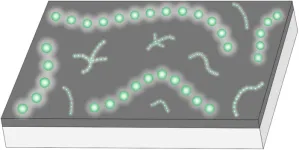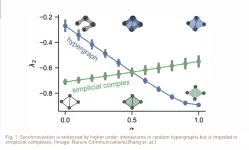(Press-News.org) A new study published in Diabetologia (the journal of the European Association for the Study of Diabetes [EASD])finds that individuals who experienced childhood adversity are at increased risk of developing type 2 diabetes (T2D) in early adulthood.
The research was conducted by Assistant Professor Leonie K. Elsenburg and colleagues at the Section of Epidemiology, Department of Public Health, University of Copenhagen, Copenhagen, Denmark and aimed to determine whether there was a link between childhood adversity and the development of T2D in early adulthood (16-38 years) among men and women.
The worldwide prevalence of T2D among adolescents and young adults has increased substantially over the past century, primarily driven by changes in lifestyles and obesity rates. This is of particular concern because early onset of the disease (before 40 years of age) appears to have a more aggressive pathology, and the individuals affected are of working age, may require lifelong treatment and face an increased risk of complications. These factors combined make identifying the risk factors for T2D in early adulthood a matter of crucial important to public health.
Childhood adversity can involve experiences such as maltreatment, physical or mental illness in the family, and poverty and has been associated with the development of diabetes even in young adults. Adverse events and circumstances can trigger physiological stress responses and affect the behaviour of the nervous system, hormones and the body’s immune response. They can also impact mental wellbeing and lead to behavioural changes that negatively impact health such as poor sleep, smoking, reduced physical activity and sedentary behaviour, increased alcohol use, and unhealthy eating which can lead to obesity and an elevated risk of developing T2D.
Previous research has revealed an association between maltreatment in childhood and the development of T2D in young adulthood, but evidence for a link with other types of adversity is scarce and sex-specific estimates are lacking. The authors also note: “There is a need for methodological improvements in this research area, including a need for prospective studies using objective and more comprehensive measures of childhood adversity.”
The researchers used data from the Danish life course cohort study (DANLIFE) which includes on the backgrounds and childhood adversities of children born in Denmark since 1 January 1980. To enable follow-up from age 16 onwards, the study sample was limited to those individuals born up to 31 December 2001 and excluded individuals diagnosed with diabetes in childhood, those with insufficient data on covariate factors, and anyone who emigrated or died before age 16.
This study population was divided into five childhood adversity groups based on annual counts of exposure (from 0 to 15 years of age) to adversities in each of three dimensions: material deprivation (family poverty and parental long-term unemployment), loss or threat of loss (parental somatic illness, sibling somatic illness, parental death, sibling death) and family dynamics (foster care placement, parental psychiatric illness, sibling psychiatric illness, parental alcohol abuse, parental drug abuse and maternal separation).
In these five groups, children experienced: 1. relatively low levels of adversity across childhood (54%); 2. material deprivation specifically in early childhood (20%); 3. material deprivation throughout childhood and adolescence (13%); 4. relatively high levels of somatic illness or death in the family (9%); and 5. relatively high levels of adversity across all three dimensions (3%)
Out of the study population of 1,277,429, a total of 2,560 women and 2,300 men developed T2D during the follow-up which lasted a mean 10.8 years. The authors found that compared with the “Low adversity” group, the risk of developing T2D in early adulthood was higher in all other adversity groups for both men and women. In the “High Adversity” group, which was characterised by high rates of adversity across all three dimensions, the risk of developing diabetes was 141% higher in men and 58% higher in women, translating into 36.2 and 18.6 additional cases per 100,0000 person-years among men and women, respectively.
After adjusting for parental education level, size for gestational age and preterm birth, the effect estimates were reduced, particularly for women in the “High Adversity” group. Compared to their counterparts who experienced low adversity during childhood, their additional risk of developing T2D was reduced from 58% to 23%, translating into 6.4 additional cases per 100,000 person-years instead of 18.6 per 100,000 person-years. Most of the reduction in the estimated risk was the result of adjusting for parental education level.
The authors found that the relative risks of developing T2D following childhood adversity were lower among women than men across all groups. In addition, the absolute effects (in terms of the number of additional cases of diabetes per 100,000 person-years) were also lower among women than men, except in the case of experiencing material deprivation in childhood, where the absolute effect was comparable between men and women.
The study reveals that individuals exposed to childhood adversity, such as poverty, illness or death in the family, and dysfunctional households are at higher risk of developing type 2 diabetes in young adulthood compared with those who experience low levels of adversity in childhood. These findings are strengthened by the large size of this population-based study, as well as its freedom from selection or recall bias. In addition, the authors point out that there is a close relationship between parental education levels children’s experience of adversity which explains some of the observed association.
The researchers conclude that a share of the T2D cases arising in young adulthood could likely be prevented through early interventions targeting the fundamental causes of childhood adversity, to reduce or even eliminate their negative effect on children’s lives.
Assistant Professor Leonie K. Elsenburg and colleagues at the Section of Epidemiology, Department of Public Health, University of Copenhagen, Copenhagen, Denmark. T) +45 35323117 E) leonie.elsenburg@sund.ku.dk
Alternative contact: Tony Kirby of Tony Kirby PR T) +44 7834 385827 E) tony.kirby@tonykirby.com
END
New study reveals that childhood adversity is linked to an increased risk of developing type 2 diabetes as young adults
2023-04-21
ELSE PRESS RELEASES FROM THIS DATE:
Reducing fatigue and errors among nurses working night shifts
2023-04-21
Nurses exposed to 40 minutes of bright light before their night shifts feel less fatigued and make fewer errors at work, according to a study led by McGill University. The nurses also slept better after their shifts.
“Healthcare workers are experiencing high levels of fatigue due to staffing shortages, difficult schedules, and heavy workloads. Further, the cost of medical errors has been estimated at tens of billions of dollars per year in North America,” says Jay Olson, the senior author of the recent study in Sleep Health, ...
Surgery most effective treatment of metabolic liver disease
2023-04-21
Metabolic (bariatric) surgery is more effective than medications and lifestyle interventions for the treatment of advanced non-alcoholic fatty liver disease.
A new paper, published today in The Lancet by King’s College London and the Catholic University of Rome, is the first to compare three active treatments of non-alcoholic Steatohepatitis (NASH) and to specifically investigate the effectiveness of metabolic surgery (weight loss surgery) in a randomised clinical trial.
Non-Alcoholic Fatty Liver Disease (NAFLD) is the most common cause of chronic liver disease, globally affecting 55% of people with type 2 diabetes and 75% of those with obesity. Non-alcoholic ...
Whales stop by Gold Coast bay for day spa fix with full body scrubs
2023-04-21
A new Griffith University study has found that humpback whales will use sandy, shallow bay areas to ‘roll’ around in sandy substrates to remove dead skin cells on their return journeys south to cooler waters.
Marine ecologist Dr Olaf Meynecke, from the Griffith-led Whales and Climate Research Program and Coastal and Marine Research Centre, used suction cup tags to track southward migrating whales between August 2021 and October 2022.
The CATS tags are fitted with integrated high-definition video, magnesium release system, a VHF transmitter for retrieval, magnetometers, ...
Horodyskia is among the oldest multicellular macroorganisms: Study
2023-04-21
Horodyskia, characterized by a string of beads with uniform size and spacing, is a kind of macroscopic fossil with a record extending from the early Mesoproterozoic Era (~1.48 Ga) to the terminal Ediacaran Period (~550 Ma).
Now, researchers led by Dr. LI Guangjin and Prof. PANG Ke from the Nanjing Institute of Geology and Palaeontology of the Chinese Academy of Sciences (NIGPAS) and Prof. CHEN Lei from Shandong University of Science and Technology have revealed that Horodyskia is among the oldest multicellular macroorganisms and may have attained its macroscopic ...
Study: Do higher-order interactions promote synchronization?
2023-04-20
APRIL 20, 2023
Researchers use networks to model the dynamics of coupled systems ranging from food webs to neurological processes. Those models originally focused on pairwise interactions, or behaviors that emerge from interactions between two entities. But in the last few years, network theorists have been asking, what about phenomena that involve three or more? In medicine, antibiotic combinations may fight a bacterial infection differently than they would on their own. In ecology, survival strategies may arise from ...
Synthetic biology meets fashion in engineered silk
2023-04-20
Scientists have long been intrigued by the remarkable properties of spider silk, which is stronger than steel yet incredibly lightweight and flexible. Now, Fuzhong Zhang, a professor of energy, environmental and chemical engineering at the McKelvey School of Engineering at Washington University in St. Louis, has made a significant breakthrough in the fabrication of synthetic spider silk, paving the way for a new era of sustainable clothing production.
Since engineering recombinant spider silk in 2018 using bacteria, Zhang has been working to increase the yield of silk threads produced from microbes while maintaining its desirable properties of enhanced ...
Study reveals a novel biomarker and a potentially improved therapy for Multiple Sclerosis and related neurodegenerative disorders
2023-04-20
Houston, TX – Degeneration of myelin, an insulating sheath required for rapid communication between nerve cells, and neuroinflammation are notable hallmarks of Multiple Sclerosis (MS) and related neurodegenerative disorders such as Alzheimer’s disease or Huntington’s disease that affect roughly 2.8 million people in the world. However, little is known about the precise molecular steps by which demyelination leads to the loss of neurons and glia, the two major types of brain cells.
A paper published recently in Cell Metabolism by a research team led by Drs. Hugo J. Bellen, Hyunglok Chung, and Hyun ...
Dr. Elizabeth Whitlock to be honored at #AGS23 for her cross-cutting work in geriatrics, anesthesiology, and epidemiology
2023-04-20
New York, NY (April 20, 2023) — The American Geriatrics Society (AGS) and the AGS Health in Aging Foundation today announced that Elizabeth L. Whitlock, MD, an Assistant Professor in the Department of Anesthesia and Perioperative Care at the University of California, San Francisco (UCSF) is the 2023 recipient of the Jeffrey H. Silverstein Memorial Award for Emerging Investigators in the Surgical and Related Medical Specialties.
The award will be presented at the 2023 AGS Annual Scientific Meeting (#AGS23) which is being held in Long Beach, CA from May 4-6 (preconference day is May 3). The award recognizes Dr. ...
Extraction influences seismicity at some hydraulic fracturing sites in Ohio
2023-04-20
A decade’s worth of research at oil and gas operations in the central and eastern United States has confirmed that fluid injection from hydraulic fracturing and wastewater disposal can induce seismicity.
Now, data from hydraulic fracturing wells in eastern Ohio indicate that extraction activities also can influence the seismicity rate, according to a presentation at the Seismological Society of America (SSA)’s 2023 Annual Meeting.
During hydraulic fracturing, well operators inject a pressurized liquid ...
Cheetahs need more space: Reintroduction in India must consider their spatial ecology
2023-04-20
In autumn 2022 and winter 2023, a total of 20 cheetahs from Namibia and South Africa were introduced to Kuno National Park in India to establish a free-ranging population – for the first time since their extinction in India 70 years ago. Although the idea may be commendable, getting it right is not so easy. Scientists of the Cheetah Research Project of Leibniz-IZW in Namibia see shortcomings in the reintroduction plan: In southern Africa, cheetahs live in a stable socio-spatial system with widely spread territories and densities ...



